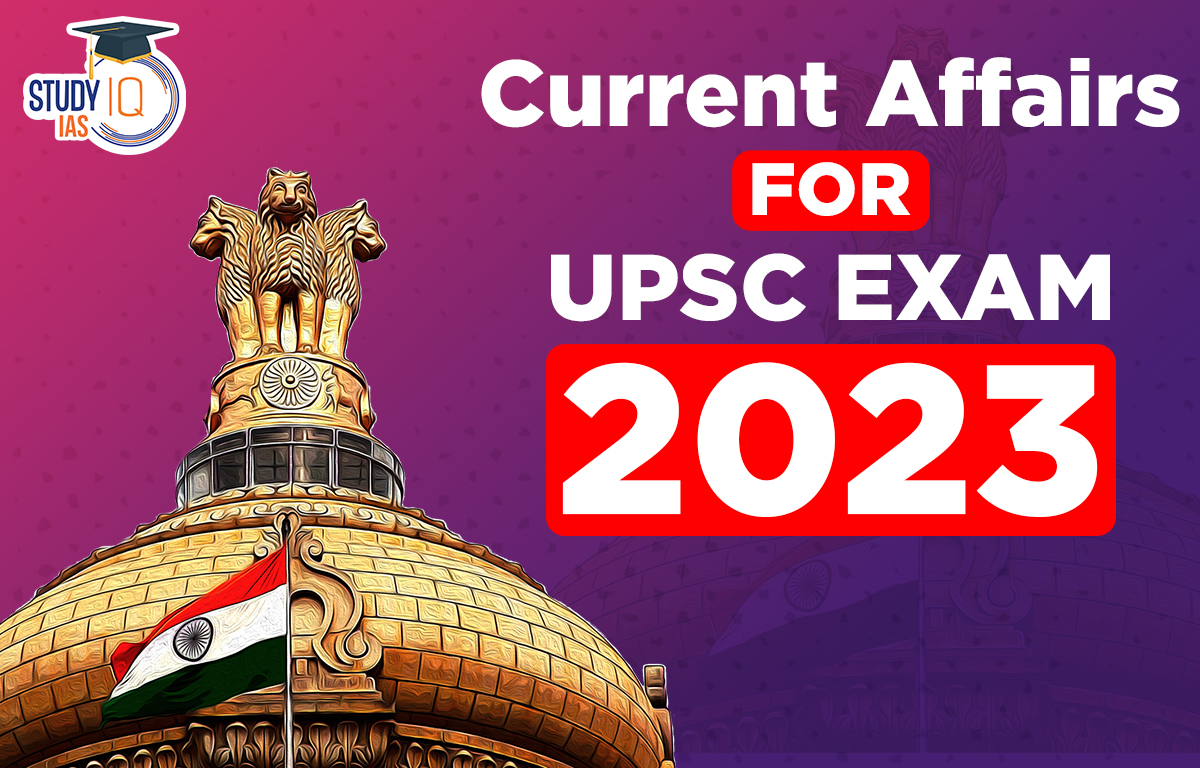Current Affairs 22nd March 2023 for UPSC Prelims Exam
Sealed Cover Jurisprudence
Context: In one Rank One Pension (OROP) case, Supreme Court refused to accept ‘sealed cover’.
About Sealed Cover Jurisprudence:
- It is the practice of seeking and accepting information from government agencies in sealed envelopes that can only be perused by judges.
- It has been followed by the Supreme Court in the past and sometimes in the lower courts as well.
- This can happen in broadly two kinds of cases:
- When the information is connected to an ongoing investigation
- When the information is personal or confidential in nature.
- It is understood that in the first situation, an ongoing investigation could be impeded by the disclosure, and in the second situation, an individual’s privacy could be affected or there may be a breach of trust.
- Powers: While a specific law does not define the doctrine of sealed cover, the Supreme Court derives its power to use it from Rule 7 of order XIII of the Supreme Court Rules and Section 123 of the Indian Evidence Act of 1872.
Rule 7 of order XIII of the Supreme Court Rules:
- According to the rule, if the Chief Justice or court directs certain information to be kept under sealed cover or considers it of confidential nature, no party would be allowed access to the contents of such information, except if the Chief Justice himself orders that the opposite party be allowed to access it.
- It also mentions that information can be kept confidential if its publication is not considered to be in the interest of the public.
Section 123 of the Indian Evidence Act of 1872:
- Under this act, official unpublished documents relating to state affairs are protected and a public officer cannot be compelled to disclose such documents.
- Other instances where information may be sought in secrecy or confidence are when its publication impedes an ongoing investigation, such as details which are part of a police case diary.
Current Affairs 21st March 2023 for UPSC Prelims Exam
G-7 and G-20
Context: The Prime Minister of Japan visited India for coordinating the G-7 and G-20 agendas on food and energy security issues.
| Criteria | G-7 | G-20 |
| Nature | G7 is an informal grouping of seven industrialized countries. | The G20 is an intergovernmental grouping of the world’s largest economies, comprising both industrialized and developing nations. |
| Members | Canada, France, Germany, Italy, Japan, the United Kingdom and the United States | US, UK, France, Canada, Mexico, Brazil, Argentina, Italy, Germany, Japan, South Korea, Russia, China, India, Indonesia, Saudi Arabia, Turkey, Russia, South Africa and EU. |
| Formation | The group was launched as an informal meet between the heads of Germany, France, Great Britain, Italy, Japan and the US.
G7 came into existence when Canada joined in 1976. In 1998, Russia joined to make it G8. After expulsion of Russia in 2014, the group became G7. |
The G20 was formed in 1999 in the backdrop of the financial crisis of the late 1990s that hit East Asia and Southeast Asia in particular. |
| Agenda | It is a global platform for discussing and coordinating solutions to major global issues, especially in the areas of trade, security, economics, and climate change. | It seeks to address major issues related to the global economy, such as international financial stability, climate change mitigation, and sustainable development. |
| Coverage | G7 group accounts for over half of global net wealth, 32 to 46 percent of global GDP and 10 percent of the world’s population.
G7 countries are responsible for 21% of global carbon dioxide emissions. Countries such as Japan (263%), Italy (151%) and US (133%) have high level of gross debt. |
The G20 bloc accounts for around 80% of gross world product (GWP), 75% of international trade, two-thirds of the global population, and 60% of the world’s land area. |
| Structure | The G7 is not based on any treaty and has no permanent secretariat or office.
Activities of the group are carried out through a presidency that rotates annually among the member states. |
The G-20 operates without a permanent secretariat or staff, with membership rotating between members.
The three-member management group of past, present and future chairs referred to as the Troika. Indonesia, India and Brazil make up the G20 Troika. |
| Success | G7 has spearheaded several major global initiatives, such as combating the HIV/AIDS pandemic, providing financial aid to developing countries, and address climate change. | It is credited for introducing trillion-dollar pledge in 2009 to help struggling economies during the global financial crisis. G20 has also successfully included developing economies in global decision-making. |
| Criticism | The G7 is criticized for its narrow membership base, outdated developmental agendas and ineffective implementation. | The G20 is usually criticized for lack of legitimacy and inadequacy in addressing global challenges.
The group does not have clear criteria for membership. It does not have powers to legally implement an agenda. |
Double Jeopardy
Context: A CBI court has sentenced former Delhi Jal Board officials for corruption, rejecting their argument of ‘double jeopardy’.
What is Double Jeopardy?
- The idea of ‘double jeopardy’ originates from Latin maxim “Nemo bis punitur pro eodem delicto”, which means that no person can be tried for the same offence twice.
- Its existence can be found in Justinian code, Canon law, Common Law, and the Fifth Amendment.
Doctrine of Double Jeopardy in India:
- In India, the idea exited even before commencement of the constitution. It can be found in General Clauses Act, of 1897 and Section 300 of the Criminal Procedure Code of 1973, which says that a person once convicted or acquitted cannot be tried for the same offence.
- The Supreme Court decision in Gopalakrishnan vs. State of Kerala (2022) emphasized that Section 300 bars the trial of a person not just for the same offence but also for any other offence on the same facts.
- Constitutional validity:
- The doctrine of double jeopardy is enshrined under Article 20 (2) of the Indian Constitution. It says that:
- No individual will be prosecuted and punished for the same offence more than once.
- It provides immunity from double punishment and bars a second prosecution in only such cases where the accused has been both prosecuted and punished for the same offence previously.
- Conditions for Applying Article 20 (2):
- Previous proceeding must have taken place before a court of law or a judicial tribunal of competent jurisdiction.
- The accused person must have been prosecuted under previous proceedings.
- The conviction or acquittal in the previous proceeding must be in force during the second trial.
- The offence during the second proceeding must be the same as that of the first proceeding for which the individual was prosecuted and punished.
- The “offence” must qualify as an offence under Section 3(38) of the General Clauses Act. The prosecution must be valid and not null, void, or abortive.
- The subsequent proceeding must be a fresh proceeding and not a continuation of the previous proceeding.
- The clause does not prevent a retrial on appeal with a direction to frame charges, provided the retrial is for the same offence or offence as the original trial.
National Security Act, 1980
Context: The National Security Act, 1980 has been invoked against separatist leader Amritpal Singh in Punjab.
What is National Security Act (NSA), 1980?
- Origin: NSA was passed by the Parliament in 1980. The act empowers the state to detain a person without a formal charge and without trial.
- Reason behind invoking:
- The act is invoked to take a person into custody, preventing them from acting in any manner prejudicial to “the security of the state” or for “maintenance of the public order”.
- Authority to invoke:
- The act is invoked through an administrative order passed either by the Divisional Commissioner or the District Magistrate (DM).
- The District Magistrate can slap NSA against an individual even if they are in police custody.
- No legal proceedings can be initiated against the official who carries out the orders under NSA.
- Provisions under NSA, 1980:
- Re-arrest: A person can be detained under the NSA even if the same person has been acquitted by the court.
- Producing before magistrate: The NSA snatches away the individual’s constitutional right to be produced before the magistrate within 24 hours.
- Provision of bail: The detained person loses the right to move a bail application before a criminal court.
- Detention without charges: Individual charged under NSA can be detained without a charge for a maximum period of 12 months.
- The detainee can be held for 10 to 12 days in special circumstances without informing them about the charges against them.
- Grounds for detention:
- Individual can be detained to prevent them from acting in any manner prejudicial to the defence of India, relations of India with friendly countries or the security of India.
- The law can also be invoked to prevent a person from acting in any manner prejudicial to the maintenance of supply and services essential to the community.
- Remedies against NSA:
- Persons detained under NSA have the right to make an effective representation before an independent advisory board, which consists of three members and is chaired by a member who is, or has been, a judge of a high court.
- The writ of habeas corpus is another remedy available under the Constitution against the state’s power of taking people into custody under the NSA.
- Criticism of NSA:
- NSA violates Article 22 of the Constitution and various provisions under the CrPC that safeguards the interest of an arrested person.
- NSA creates exception for producing an arrested person before the nearest Magistrate within 24 hours, which is necessitated under CrPC.
- There are accusations that NSA is misused by authorities to silence political opponents or those who are critical of the government.
Hailstorm
Context: Recently, Madhya Pradesh Chief Minister visited villages in Vidisha district to take stock of crops damaged by hailstorm and unseasonal rains.
About Hailstorm
- Hailstorm is a severe weather phenomenon that produces ice as precipitation.
- Hail is solid precipitation made of balls or irregular lumps of ice, each of which is called a hailstone.
- Unlike graupel or snow-ice pellets that are smaller and translucent, hailstones consist mostly of water ice and measure between 5 mm and 15 cm in diameter.
- Any thunderstorm, which produces hail that reaches the ground, is termed a hailstorm.
- In India, hailstorms mostly affect the northeast and western Himalayas, with the maximum strikes in March and April.
Mechanism of Hailstorm
- A hailstone begins as a water droplet that is swept up by an updraft inside of a thundercloud. Inside the cloud, there are a large number of other supercooled water droplets already present.
- These supercooled particles will adhere to the water droplet’s surface, forming layers of ice around it.
- As the water droplet reaches higher elevations within the cloud it comes into contact with more and more supercooled particles.
- The hail embryo will grow larger and larger as it reaches higher altitudes in the updraft.
- The hailstone will reach a size and weight where gravity will begin to act on it and pull it down.
- Hail forms as super-cooled droplets, ice crystals and water freeze upon an embryo hailstone.
- Once hail forms, gravity will bring the hail to the earth’s surface. If the updraft is stronger than the pull of gravity, the hailstone will continue to grow.
- Once the hail reaches a size that the updraft can no longer keep aloft, the hail stone will make its way down.

National Chambal Sanctuary
Context: Recently, Rajasthan, Madhya Pradesh and Uttar Pradesh have commenced joint action to stop illegal sand mining in National Chambal Sanctuary.
- Illegal sand mining is threatening the flora and fauna in some parts of the sanctuary.
About National Chambal Sanctuary
- It was set up in 1979 as a riverine sanctuary.
- It is called a tri-state sanctuary due to its diverse area in three states.
- Chambal river cuts through the mazes of ravines and hills in the sanctuary.
- It supports the largest population of Gharials in the wild.
- Gharials are listed as ‘Critically Endangered’ in the IUCN Red List.
- The 5,400 sq. km. sanctuary is protected under the Wildlife Protection Act, 1972.
- It is listed as an ‘Important Bird and Biodiversity Area’ and is also a proposed Ramsar site.
- Rich Fauna: About 320 species of resident and migratory birds inhabit the sanctuary, and migratory birds from Siberia form part of its rich avian fauna.
Interpol Notice
Context: Recently, Central Bureau of Investigation (CBI) has asked Commission for Control of Interpol’s Files (CCF), to restore the Red Notice against fugitive Mehul Choksi.
About Interpol (International Criminal Police Organisation)
- It was established in 1923.
- It is an inter-governmental organisation comprising 195 member countries.
- It helps police forces in all these countries to better coordinate their actions.
- It enables member countries to share and access data on crimes and criminals, and offers a range of technical and operational support.
- Interpol has a National Central Bureau (NCB) in each member country, which is the central point of contact for both the general secretariat and the other NCBs around the world.
- Central Bureau of Investigation (CBI) in India is officially designated single point of contact for liaison with the Interpol.
- It is headquartered in Lyon, France.
About Interpol Notices:
- Interpol notices are international requests made by member countries for cooperation or alerts allowing police in member countries to share critical crime-related information.
Types of Interpol Notice
- Red Notice: To seek the location/arrest of a person wanted by a judicial jurisdiction or an international tribunal with a view to his/her extradition.
- Green Notice: To warn about a person’s criminal activities if that person is considered to be a possible threat to public safety.
- Blue Notice: To locate, identify or obtain information on a person of interest in a criminal investigation.
- Yellow Notice: To locate a missing person or to identify a person unable to identify himself/herself.
- Black Notice: To seek information on unidentified bodies.
- Orange Notice: To warn of an event, a person, an object or a process representing an imminent threat and danger to persons or property.
- Purple Notice: To provide information on modus operandi, procedures, objects, devices, or hiding places used by criminals.
- Interpol UNSC Special Notice: To inform Interpol’s members that an individual or an entity is subject to UN sanctions.

About Commission for Control of Interpol’s Files (CCF)
- It is a separate Interpol body.
- It is “not under the control” of the Interpol Secretariat.
- It is mainly staffed by elected lawyers from different countries where people can challenge decisions to declare them fugitives.


 Personality Rights in India: Expanding P...
Personality Rights in India: Expanding P...
 Judicial Recognition of Child Traffickin...
Judicial Recognition of Child Traffickin...
 Misrepresentation and Fraud in Digital T...
Misrepresentation and Fraud in Digital T...

























